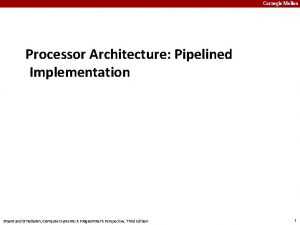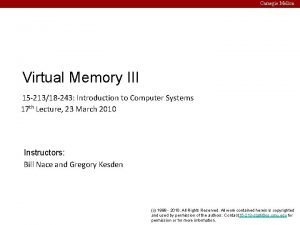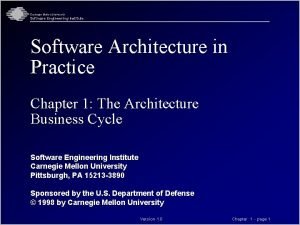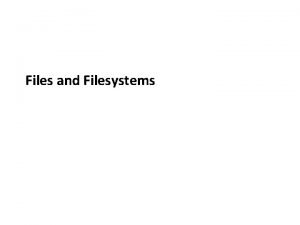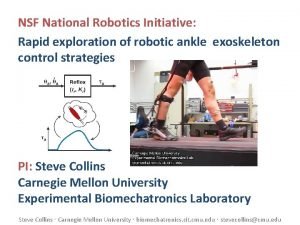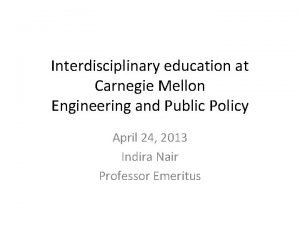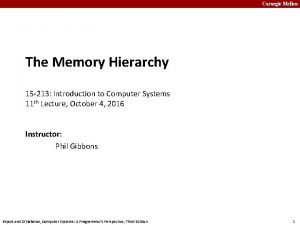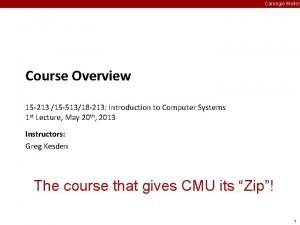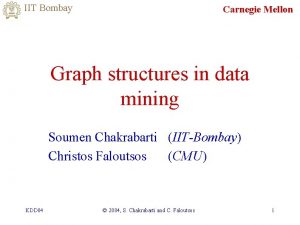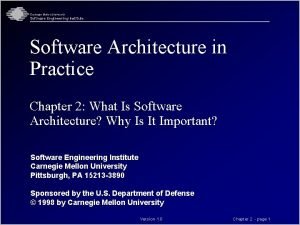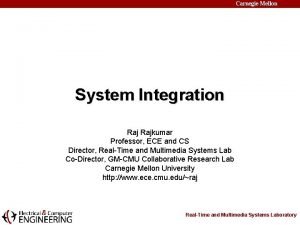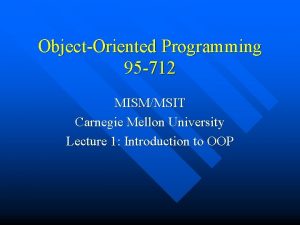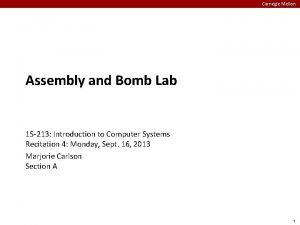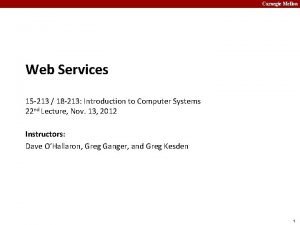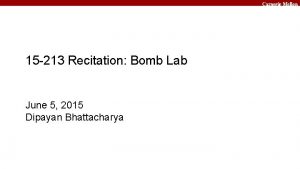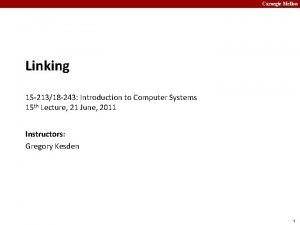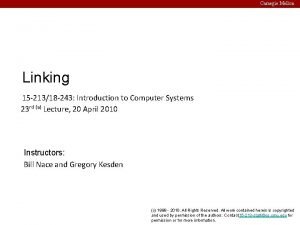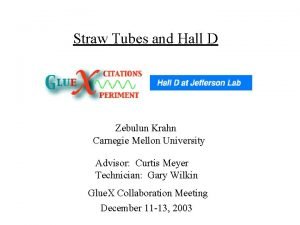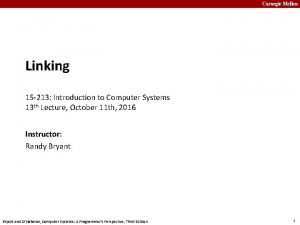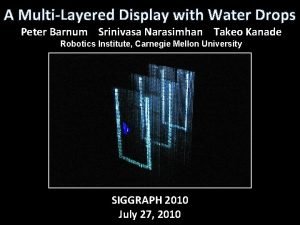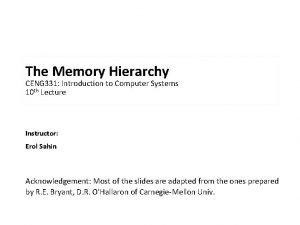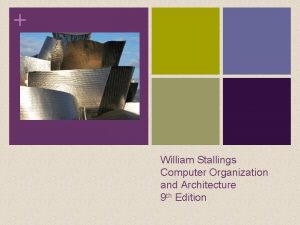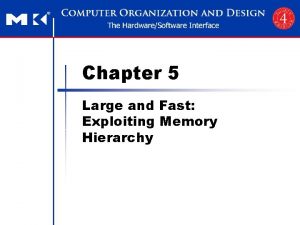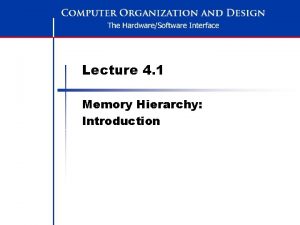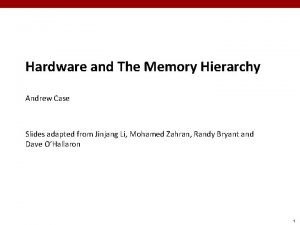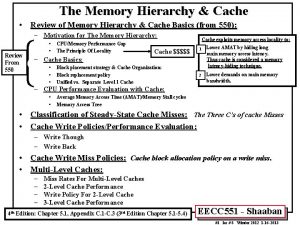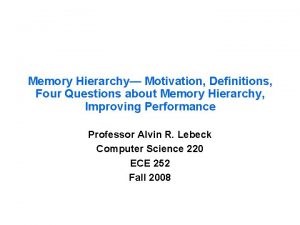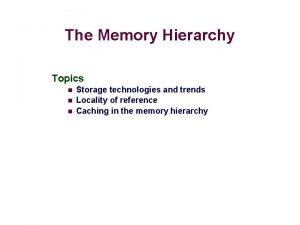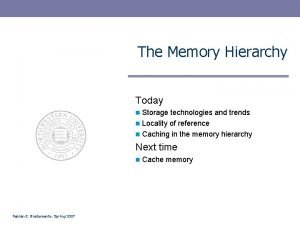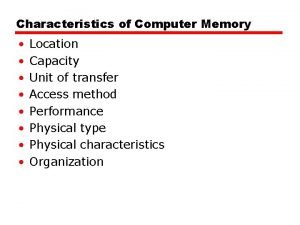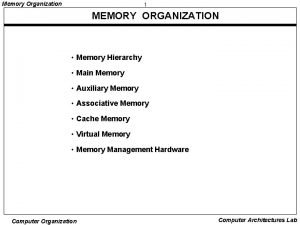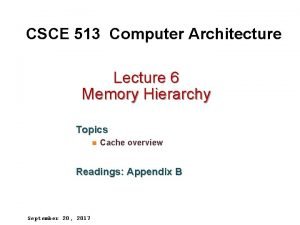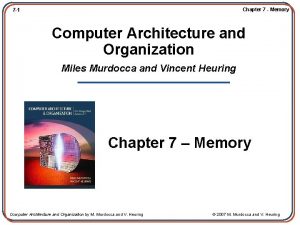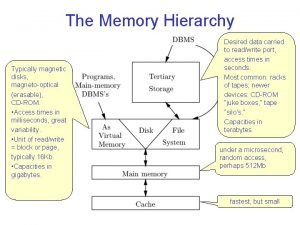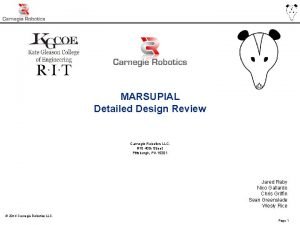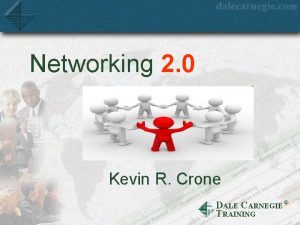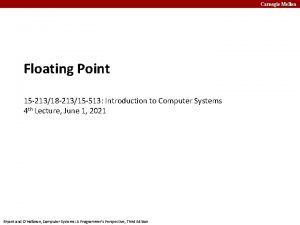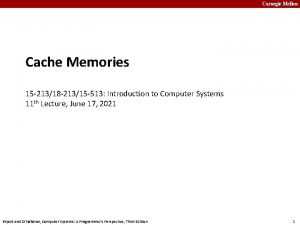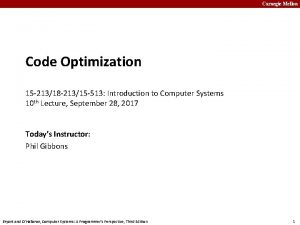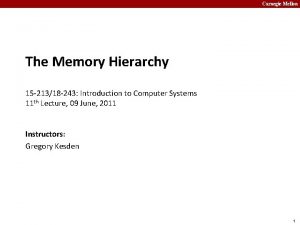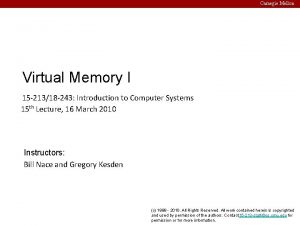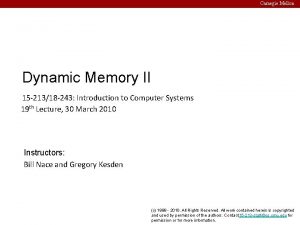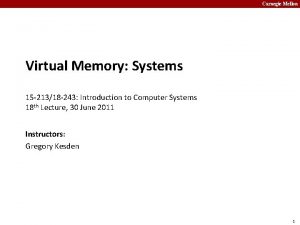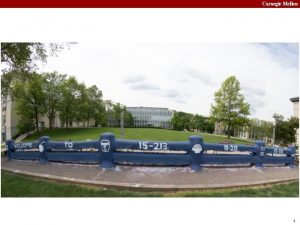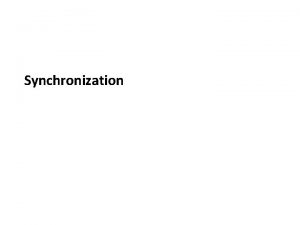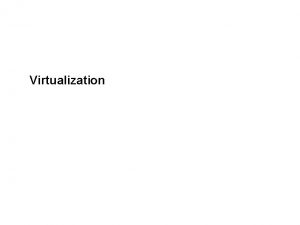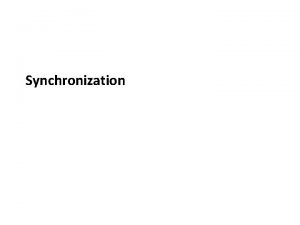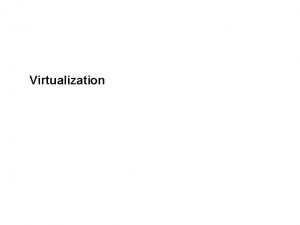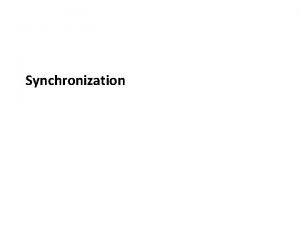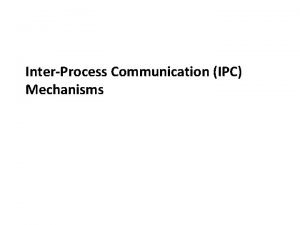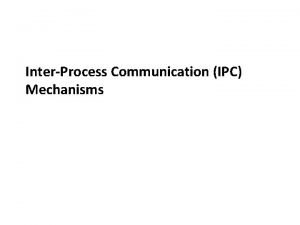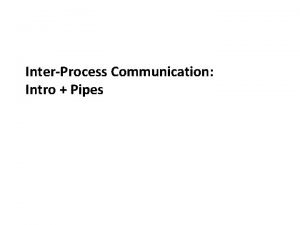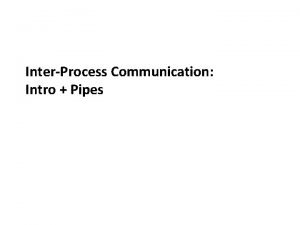Carnegie Mellon The Memory Hierarchy 15 21318 21315




































































- Slides: 68

Carnegie Mellon The Memory Hierarchy 15 -213/18 -213/15 -513: Introduction to Computer Systems 11 th Lecture, October 3, 2017 Today’s Instructor: Phil Gibbons Bryant and O’Hallaron, Computer Systems: A Programmer’s Perspective, Third Edition 1

Carnegie Mellon Today ¢ ¢ ¢ Storage technologies and trends Locality of reference Caching in the memory hierarchy Bryant and O’Hallaron, Computer Systems: A Programmer’s Perspective, Third Edition 2

Carnegie Mellon Random-Access Memory (RAM) ¢ Key features § RAM is traditionally packaged as a chip. § Basic storage unit is normally a cell (one bit per cell). § Multiple RAM chips form a memory. ¢ RAM comes in two varieties: § SRAM (Static RAM) § DRAM (Dynamic RAM) Bryant and O’Hallaron, Computer Systems: A Programmer’s Perspective, Third Edition 3

Carnegie Mellon SRAM vs DRAM Summary Trans. Access Needs per bit time refresh? EDC? Cost Applications SRAM 4 or 6 1 X No Maybe 100 x Cache memories DRAM 1 Yes Main memories, frame buffers 10 X Bryant and O’Hallaron, Computer Systems: A Programmer’s Perspective, Third Edition 1 X 4

Carnegie Mellon Enhanced DRAMs ¢ Basic DRAM cell has not changed since its invention in 1966. § Commercialized by Intel in 1970. ¢ DRAM cores with better interface logic and faster I/O : § Synchronous DRAM (SDRAM) Uses a conventional clock signal instead of asynchronous control § Allows reuse of the row addresses (e. g. , RAS, CAS, CAS) § § Double data-rate synchronous DRAM (DDR SDRAM) Double edge clocking sends two bits per cycle per pin § Different types distinguished by size of small prefetch buffer: – DDR (2 bits), DDR 2 (4 bits), DDR 3 (8 bits) § By 2010, standard for most server and desktop systems § Intel Core i 7 supports DDR 3 and DDR 4 SDRAM § Bryant and O’Hallaron, Computer Systems: A Programmer’s Perspective, Third Edition 5

Carnegie Mellon Nonvolatile Memories ¢ ¢ DRAM and SRAM are volatile memories § Lose information if powered off. Nonvolatile memories retain value even if powered off § Read-only memory (ROM): programmed during production § Programmable ROM (PROM): can be programmed once § Eraseable PROM (EPROM): can be bulk erased (UV, X-Ray) § Electrically eraseable PROM (EEPROM): electronic erase capability § Flash memory: EEPROMs, with partial (block-level) erase capability Wears out after about 100, 000 erasings § 3 D XPoint (Intel Optane) & emerging NVMs § New materials § ¢ Uses for Nonvolatile Memories § Firmware programs stored in a ROM (BIOS, controllers for disks, network cards, graphics accelerators, security subsystems, …) § Solid state disks (replace rotating disks in thumb drives, smart phones, mp 3 players, tablets, laptops, data centers, …) § Disk caches Bryant and O’Hallaron, Computer Systems: A Programmer’s Perspective, Third Edition 6

Carnegie Mellon Traditional Bus Structure Connecting CPU and Memory ¢ ¢ A bus is a collection of parallel wires that carry address, data, and control signals. Buses are typically shared by multiple devices. CPU chip Register file ALU System bus Bus interface Bryant and O’Hallaron, Computer Systems: A Programmer’s Perspective, Third Edition I/O bridge Memory bus Main memory 7

Carnegie Mellon Memory Read Transaction (1) ¢ CPU places address A on the memory bus. Register file %rax Load operation: movq A, %rax ALU I/O bridge Bus interface Bryant and O’Hallaron, Computer Systems: A Programmer’s Perspective, Third Edition A Main memory 0 x A 8

Carnegie Mellon Memory Read Transaction (2) ¢ Main memory reads A from the memory bus, retrieves word x, and places it on the bus. Register file %rax Load operation: movq A, %rax ALU Main memory I/O bridge Bus interface Bryant and O’Hallaron, Computer Systems: A Programmer’s Perspective, Third Edition 0 x x A 9

Carnegie Mellon Memory Read Transaction (3) ¢ CPU read word x from the bus and copies it into register %rax. Register file %rax x Load operation: movq A, %rax ALU I/O bridge Bus interface Bryant and O’Hallaron, Computer Systems: A Programmer’s Perspective, Third Edition Main memory 0 x A 10

Carnegie Mellon Memory Write Transaction (1) ¢ CPU places address A on bus. Main memory reads it and waits for the corresponding data word to arrive. Register file %rax y Store operation: movq %rax, A ALU I/O bridge Bus interface Bryant and O’Hallaron, Computer Systems: A Programmer’s Perspective, Third Edition A Main memory 0 A 11

Carnegie Mellon Memory Write Transaction (2) ¢ CPU places data word y on the bus. Register file %rax y Store operation: movq %rax, A ALU I/O bridge Bus interface Bryant and O’Hallaron, Computer Systems: A Programmer’s Perspective, Third Edition y Main memory 0 A 12

Carnegie Mellon Memory Write Transaction (3) ¢ Main memory reads data word y from the bus and stores it at address A. Register file %rax y Store operation: movq %rax, A ALU I/O bridge Bus interface Bryant and O’Hallaron, Computer Systems: A Programmer’s Perspective, Third Edition Main memory 0 y A 13

Carnegie Mellon What’s Inside A Disk Drive? Arm Spindle Platters Actuator SCSI connector Electronics (including a processor and memory!) Image courtesy of Seagate Technology Bryant and O’Hallaron, Computer Systems: A Programmer’s Perspective, Third Edition 14

Carnegie Mellon Disk Geometry ¢ ¢ ¢ Disks consist of platters, each with two surfaces. Each surface consists of concentric rings called tracks. Each track consists of sectors separated by gaps. Tracks Surface Track k Gaps Spindle Sectors Bryant and O’Hallaron, Computer Systems: A Programmer’s Perspective, Third Edition 15

Carnegie Mellon Disk Geometry (Multiple-Platter View) ¢ Aligned tracks form a cylinder. Cylinder k Surface 0 Platter 0 Surface 1 Surface 2 Platter 1 Surface 3 Surface 4 Platter 2 Surface 5 Spindle Bryant and O’Hallaron, Computer Systems: A Programmer’s Perspective, Third Edition 16

Carnegie Mellon Disk Capacity ¢ Capacity: maximum number of bits that can be stored. § Vendors express capacity in units of gigabytes (GB), where 1 GB = 109 Bytes. ¢ Capacity is determined by these technology factors: § Recording density (bits/in): number of bits that can be squeezed into a 1 inch segment of a track. § Track density (tracks/in): number of tracks that can be squeezed into a 1 inch radial segment. § Areal density (bits/in 2): product of recording and track density. Bryant and O’Hallaron, Computer Systems: A Programmer’s Perspective, Third Edition 17

Carnegie Mellon Recording zones Modern disks partition tracks into disjoint subsets called recording zones § Each track in a zone has the same number of sectors, determined by the circumference of innermost track. § Each zone has a different number of sectors/track, outer zones have more sectors/track than inner zones. § So we use average number of sectors/track when computing capacity. Bryant and O’Hallaron, Computer Systems: A Programmer’s Perspective, Third Edition Sector … ¢ Zone Spindle 18

Carnegie Mellon Computing Disk Capacity = (# bytes/sector) x (avg. # sectors/track) x (# tracks/surface) x (# surfaces/platter) x (# platters/disk) Example: § 512 bytes/sector § 300 sectors/track (on average) § 20, 000 tracks/surface § 2 surfaces/platter § 5 platters/disk Capacity = 512 x 300 x 20, 000 x 2 x 5 = 30, 720, 000 = 30. 72 GB Bryant and O’Hallaron, Computer Systems: A Programmer’s Perspective, Third Edition 19

Carnegie Mellon Disk Operation (Single-Platter View) The disk surface spins at a fixed rotational rate spindle The read/write head is attached to the end of the arm and flies over the disk surface on a thin cushion of air. spindle By moving radially, the arm can position the read/write head over any track. Bryant and O’Hallaron, Computer Systems: A Programmer’s Perspective, Third Edition 20

Carnegie Mellon Disk Operation (Multi-Platter View) Read/write heads move in unison from cylinder to cylinder Arm Spindle Bryant and O’Hallaron, Computer Systems: A Programmer’s Perspective, Third Edition 21

Carnegie Mellon Disk Structure - top view of single platter Surface organized into tracks Tracks divided into sectors Bryant and O’Hallaron, Computer Systems: A Programmer’s Perspective, Third Edition 22

Carnegie Mellon Disk Access Head in position above a track Bryant and O’Hallaron, Computer Systems: A Programmer’s Perspective, Third Edition 23

Carnegie Mellon Disk Access Rotation is counter-clockwise Bryant and O’Hallaron, Computer Systems: A Programmer’s Perspective, Third Edition 24

Carnegie Mellon Disk Access – Read About to read blue sector Bryant and O’Hallaron, Computer Systems: A Programmer’s Perspective, Third Edition 25

Carnegie Mellon Disk Access – Read After BLUE read After reading blue sector Bryant and O’Hallaron, Computer Systems: A Programmer’s Perspective, Third Edition 26

Carnegie Mellon Disk Access – Read After BLUE read Red request scheduled next Bryant and O’Hallaron, Computer Systems: A Programmer’s Perspective, Third Edition 27

Carnegie Mellon Disk Access – Seek After BLUE read Seek for RED Seek to red’s track Bryant and O’Hallaron, Computer Systems: A Programmer’s Perspective, Third Edition 28

Carnegie Mellon Disk Access – Rotational Latency After BLUE read Seek for RED Rotational latency Wait for red sector to rotate around Bryant and O’Hallaron, Computer Systems: A Programmer’s Perspective, Third Edition 29

Carnegie Mellon Disk Access – Read After BLUE read Seek for RED Rotational latency After RED read Complete read of red Bryant and O’Hallaron, Computer Systems: A Programmer’s Perspective, Third Edition 30

Carnegie Mellon Disk Access – Service Time Components After BLUE read Seek for RED Rotational latency After RED read Data transfer Seek Rotational latency Data transfer Bryant and O’Hallaron, Computer Systems: A Programmer’s Perspective, Third Edition 31

Carnegie Mellon Disk Access Time ¢ Average time to access some target sector approximated by: § Taccess = Tavg seek + Tavg rotation + Tavg transfer ¢ Seek time (Tavg seek) § Time to position heads over cylinder containing target sector. § Typical Tavg seek is 3— 9 ms ¢ Rotational latency (Tavg rotation) § Time waiting for first bit of target sector to pass under r/w head. § Tavg rotation = 1/2 x 1/RPMs x 60 sec/1 min § Typical Tavg rotation = 7, 200 RPMs ¢ Transfer time (Tavg transfer) § Time to read the bits in the target sector. § Tavg transfer = 1/RPM x 1/(avg # sectors/track) x 60 secs/1 min. Bryant and O’Hallaron, Computer Systems: A Programmer’s Perspective, Third Edition 32

Carnegie Mellon Disk Access Time Example ¢ Given: § Rotational rate = 7, 200 RPM § Average seek time = 9 ms. § Avg # sectors/track = 400. ¢ Derived: § Tavg rotation = § Tavg transfer = § Taccess = Bryant and O’Hallaron, Computer Systems: A Programmer’s Perspective, Third Edition 33

Carnegie Mellon Disk Access Time Example ¢ Given: § Rotational rate = 7, 200 RPM § Average seek time = 9 ms. § Avg # sectors/track = 400. ¢ Derived: § Tavg rotation = 1/2 x (60 secs/7200 RPM) x 1000 ms/sec = 4 ms. § Tavg transfer = 60/7200 RPM x 1/400 secs/track x 1000 ms/sec = 0. 02 ms § Taccess = 9 ms + 4 ms + 0. 02 ms ¢ Important points: § Access time dominated by seek time and rotational latency. § First bit in a sector is the most expensive, the rest are free. § SRAM access time is about 4 ns/doubleword, DRAM about 60 ns Disk is about 40, 000 times slower than SRAM, § 2, 500 times slower then DRAM. § Bryant and O’Hallaron, Computer Systems: A Programmer’s Perspective, Third Edition 34

Carnegie Mellon Logical Disk Blocks ¢ Modern disks present a simpler abstract view of the complex sector geometry: § The set of available sectors is modeled as a sequence of b-sized logical blocks (0, 1, 2, . . . ) ¢ Mapping between logical blocks and actual (physical) sectors § Maintained by hardware/firmware device called disk controller. § Converts requests for logical blocks into (surface, track, sector) triples. ¢ Allows controller to set aside spare cylinders for each zone. § Accounts for the difference in “formatted capacity” and “maximum capacity”. Bryant and O’Hallaron, Computer Systems: A Programmer’s Perspective, Third Edition 35

Carnegie Mellon I/O Bus CPU chip Register file ALU System bus Memory bus Main memory I/O bridge Bus interface I/O bus USB controller Graphics adapter Mouse Keyboard Monitor Disk controller Expansion slots for other devices such as network adapters. Disk Bryant and O’Hallaron, Computer Systems: A Programmer’s Perspective, Third Edition 36

Carnegie Mellon Reading a Disk Sector (1) CPU chip Register file ALU CPU initiates a disk read by writing a command, logical block number, and destination memory address to a port (address) associated with disk controller. Main memory Bus interface I/O bus USB controller mouse keyboard Graphics adapter Disk controller Monitor Disk Bryant and O’Hallaron, Computer Systems: A Programmer’s Perspective, Third Edition 37

Carnegie Mellon Reading a Disk Sector (2) CPU chip Register file ALU Disk controller reads the sector and performs a direct memory access (DMA) transfer into main memory. Main memory Bus interface I/O bus USB controller Graphics adapter Mouse Keyboard Monitor Disk controller Disk Bryant and O’Hallaron, Computer Systems: A Programmer’s Perspective, Third Edition 38

Carnegie Mellon Reading a Disk Sector (3) CPU chip Register file ALU When the DMA transfer completes, the disk controller notifies the CPU with an interrupt (i. e. , asserts a special “interrupt” pin on the CPU). Main memory Bus interface I/O bus USB controller Graphics adapter Mouse Keyboard Monitor Disk controller Disk Bryant and O’Hallaron, Computer Systems: A Programmer’s Perspective, Third Edition 39

Carnegie Mellon Solid State Disks (SSDs) I/O bus Requests to read and write logical disk blocks Solid State Disk (SSD) Flash translation layer Flash memory Block 0 Page 0 ¢ ¢ Page 1 Block B-1 … Page P-1 … Page 0 Page 1 … Page P-1 Pages: 512 KB to 4 KB, Blocks: 32 to 128 pages Data read/written in units of pages. Page can be written only after its block has been erased. A block wears out after about 100, 000 repeated writes. Bryant and O’Hallaron, Computer Systems: A Programmer’s Perspective, Third Edition 40

Carnegie Mellon SSD Performance Characteristics Sequential read tput Random read tput Avg seq read time ¢ 550 MB/s 365 MB/s 50 us Sequential write tput Random write tput Avg seq write time 470 MB/s 303 MB/s 60 us Sequential access faster than random access § Common theme in the memory hierarchy ¢ Random writes are somewhat slower § Erasing a block takes a long time (~1 ms). § Modifying a block page requires all other pages to be copied to new block. § In earlier SSDs, the read/write gap was much larger. Fixed by flash translation layer. Source: Intel SSD 730 product specification. Bryant and O’Hallaron, Computer Systems: A Programmer’s Perspective, Third Edition 41

Carnegie Mellon SSD Tradeoffs vs Rotating Disks ¢ Advantages § No moving parts faster, less power, more rugged ¢ Disadvantages § Have the potential to wear out Mitigated by “wear leveling logic” in flash translation layer § E. g. Intel SSD 730 guarantees 128 petabyte (128 x 10 15 bytes) of writes before they wear out § In 2015, about 30 times more expensive per byte § ¢ Applications § MP 3 players, smart phones, laptops § Increasingly common in desktops and servers Bryant and O’Hallaron, Computer Systems: A Programmer’s Perspective, Third Edition 42

Carnegie Mellon Quiz Time! Check out: https: //canvas. cmu. edu/courses/1221 Bryant and O’Hallaron, Computer Systems: A Programmer’s Perspective, Third Edition 43

Carnegie Mellon The CPU-Memory Gap The gap widens between DRAM, disk, and CPU speeds. 100 000, 0 Disk 10 000, 0 1 000, 0 SSD Time (ns) 100 000, 0 Disk seek time 10 000, 0 SSD access time 1 000, 0 DRAM access time DRAM 100, 0 10, 0 SRAM access time CPU cycle time Effective CPU cycle time 1, 0 CPU 0, 1 0, 0 1985 1990 1995 2000 2003 Year Bryant and O’Hallaron, Computer Systems: A Programmer’s Perspective, Third Edition 2005 2010 2015 44

Carnegie Mellon Locality to the Rescue! The key to bridging this CPU-Memory gap is a fundamental property of computer programs known as locality. Bryant and O’Hallaron, Computer Systems: A Programmer’s Perspective, Third Edition 45

Carnegie Mellon Today ¢ ¢ ¢ Storage technologies and trends Locality of reference Caching in the memory hierarchy Bryant and O’Hallaron, Computer Systems: A Programmer’s Perspective, Third Edition 46

Carnegie Mellon Locality ¢ ¢ Principle of Locality: Programs tend to use data and instructions with addresses near or equal to those they have used recently Temporal locality: § Recently referenced items are likely to be referenced again in the near future ¢ Spatial locality: § Items with nearby addresses tend to be referenced close together in time Bryant and O’Hallaron, Computer Systems: A Programmer’s Perspective, Third Edition 47

Carnegie Mellon Locality Example sum = 0; for (i = 0; i < n; i++) sum += a[i]; return sum; ¢ Data references § Reference array elements in succession (stride-1 reference pattern). § Reference variable sum each iteration. ¢ Instruction references § Reference instructions in sequence. § Cycle through loop repeatedly. Bryant and O’Hallaron, Computer Systems: A Programmer’s Perspective, Third Edition Spatial or Temporal Locality? spatial temporal 48

Carnegie Mellon Qualitative Estimates of Locality ¢ ¢ Claim: Being able to look at code and get a qualitative sense of its locality is a key skill for a professional programmer. Question: Does this function have good locality with respect to array a? int sum_array_rows(int a[M][N]) { int i, j, sum = 0; for (i = 0; i < M; i++) for (j = 0; j < N; j++) sum += a[i][j]; return sum; Hint: array layout is row-major order Answer: yes } Bryant and O’Hallaron, Computer Systems: A Programmer’s Perspective, Third Edition 49

Carnegie Mellon Locality Example ¢ Question: Does this function have good locality with respect to array a? int sum_array_cols(int a[M][N]) { int i, j, sum = 0; for (j = 0; j < N; j++) for (i = 0; i < M; i++) sum += a[i][j]; return sum; } Answer: no, unless… M is very small Bryant and O’Hallaron, Computer Systems: A Programmer’s Perspective, Third Edition 50

Carnegie Mellon Locality Example ¢ Question: Can you permute the loops so that the function scans the 3 -d array a with a stride-1 reference pattern (and thus has good spatial locality)? int sum_array_3 d(int a[M][N][N]) { int i, j, k, sum = 0; for (i = 0; i < N; i++) for (j = 0; j < N; j++) for (k = 0; k < M; k++) sum += a[k][i][j]; return sum; } Answer: make j the inner loop Bryant and O’Hallaron, Computer Systems: A Programmer’s Perspective, Third Edition 51

Carnegie Mellon Memory Hierarchies ¢ Some fundamental and enduring properties of hardware and software: § Fast storage technologies cost more per byte, have less capacity, and require more power (heat!). § The gap between CPU and main memory speed is widening. § Well-written programs tend to exhibit good locality. ¢ ¢ These fundamental properties complement each other beautifully. They suggest an approach for organizing memory and storage systems known as a memory hierarchy. Bryant and O’Hallaron, Computer Systems: A Programmer’s Perspective, Third Edition 52

Carnegie Mellon Today ¢ ¢ ¢ Storage technologies and trends Locality of reference Caching in the memory hierarchy Bryant and O’Hallaron, Computer Systems: A Programmer’s Perspective, Third Edition 53

Example Memory Hierarchy Smaller, faster, and costlier (per byte) storage devices Larger, slower, and cheaper (per byte) storage L 5: devices L 6: L 1: L 2: L 3: L 4: Carnegie Mellon L 0: Regs L 1 cache (SRAM) CPU registers hold words retrieved from the L 1 cache. L 2 cache (SRAM) L 1 cache holds cache lines retrieved from the L 2 cache. L 3 cache (SRAM) Main memory (DRAM) Local secondary storage (local disks) Remote secondary storage (e. g. , Web servers) Bryant and O’Hallaron, Computer Systems: A Programmer’s Perspective, Third Edition L 2 cache holds cache lines retrieved from L 3 cache holds cache lines retrieved from main memory. Main memory holds disk blocks retrieved from local disks. Local disks hold files retrieved from disks on remote servers. 54

Carnegie Mellon Caches ¢ ¢ Cache: A smaller, faster storage device that acts as a staging area for a subset of the data in a larger, slower device. Fundamental idea of a memory hierarchy: § For each k, the faster, smaller device at level k serves as a cache for the larger, slower device at level k+1. ¢ Why do memory hierarchies work? § Because of locality, programs tend to access the data at level k more often than they access the data at level k+1. § Thus, the storage at level k+1 can be slower, and thus larger and cheaper bit. ¢ Big Idea (Ideal): The memory hierarchy creates a large pool of storage that costs as much as the cheap storage near the bottom, but that serves data to programs at the rate of the fast storage near the top. Bryant and O’Hallaron, Computer Systems: A Programmer’s Perspective, Third Edition 55

Carnegie Mellon General Cache Concepts Cache 8 4 9 3 Data is copied in block-sized transfer units 10 4 Memory 14 10 Smaller, faster, more expensive memory caches a subset of the blocks 0 1 2 3 4 5 6 7 8 9 10 11 12 13 14 15 Bryant and O’Hallaron, Computer Systems: A Programmer’s Perspective, Third Edition Larger, slower, cheaper memory viewed as partitioned into “blocks” 56

Carnegie Mellon General Cache Concepts: Hit Request: 14 Cache 8 9 14 3 Memory 0 1 2 3 4 5 6 7 8 9 10 11 12 13 14 15 Bryant and O’Hallaron, Computer Systems: A Programmer’s Perspective, Third Edition Data in block b is needed Block b is in cache: Hit! 57

Carnegie Mellon General Cache Concepts: Miss Request: 12 Cache 8 9 12 3 Request: 12 12 Memory 14 0 1 2 3 4 5 6 7 8 9 10 11 12 13 14 15 Bryant and O’Hallaron, Computer Systems: A Programmer’s Perspective, Third Edition Data in block b is needed Block b is not in cache: Miss! Block b is fetched from memory Block b is stored in cache • Placement policy: determines where b goes • Replacement policy: determines which block gets evicted (victim) 58

Carnegie Mellon General Caching Concepts: 3 Types of Cache Misses ¢ Cold (compulsory) miss § Cold misses occur because the cache starts empty and this is the first reference to the block. ¢ Capacity miss § Occurs when the set of active cache blocks (working set) is larger than the cache. ¢ Conflict miss § Most caches limit blocks at level k+1 to a small subset (sometimes a singleton) of the block positions at level k. § E. g. Block i at level k+1 must be placed in block (i mod 4) at level k. § Conflict misses occur when the level k cache is large enough, but multiple data objects all map to the same level k block. § E. g. Referencing blocks 0, 8, . . . would miss every time. Bryant and O’Hallaron, Computer Systems: A Programmer’s Perspective, Third Edition 59

Carnegie Mellon Examples of Caching in the Mem. Hierarchy Cache Type What is Cached? Where is it Cached? Latency (cycles) Registers 4 -8 bytes words CPU core TLB Address translations On-Chip TLB 0 Hardware MMU L 1 cache 64 -byte blocks On-Chip L 1 4 Hardware L 2 cache 64 -byte blocks On-Chip L 2 10 Hardware Virtual Memory 4 -KB pages Main memory 100 Hardware + OS Buffer cache Parts of files Main memory 100 OS Disk cache Disk sectors Disk controller Network buffer cache Parts of files Local disk 10, 000 NFS client Browser cache Web pages Local disk 10, 000 Web browser Web cache Web pages Remote server disks Bryant and O’Hallaron, Computer Systems: A Programmer’s Perspective, Third Edition Managed By 0 Compiler 100, 000 Disk firmware 1, 000, 000 Web proxy server 60

Carnegie Mellon Summary ¢ ¢ ¢ The speed gap between CPU, memory and mass storage continues to widen. Well-written programs exhibit a property called locality. Memory hierarchies based on caching close the gap by exploiting locality. Bryant and O’Hallaron, Computer Systems: A Programmer’s Perspective, Third Edition 61

Carnegie Mellon Supplemental slides Bryant and O’Hallaron, Computer Systems: A Programmer’s Perspective, Third Edition 62

Carnegie Mellon Conventional DRAM Organization ¢ d x w DRAM: § dw total bits organized as d supercells of size w bits 16 x 8 DRAM chip 0 2 3 0 2 bits / addr rows Memory controller (to/from CPU) 1 cols 1 supercell (2, 1) 2 8 bits / 3 data Internal row buffer Bryant and O’Hallaron, Computer Systems: A Programmer’s Perspective, Third Edition 63

Carnegie Mellon Reading DRAM Supercell (2, 1) Step 1(a): Row access strobe (RAS) selects row 2. Step 1(b): Row 2 copied from DRAM array to row buffer. 16 x 8 DRAM chip 0 RAS = 2 2 / 2 3 0 addr Rows Memory controller 1 Cols 1 2 8 / 3 data Internal row buffer Bryant and O’Hallaron, Computer Systems: A Programmer’s Perspective, Third Edition 64

Carnegie Mellon Reading DRAM Supercell (2, 1) Step 2(a): Column access strobe (CAS) selects column 1. Step 2(b): Supercell (2, 1) copied from buffer to data lines, and eventually back to the CPU. 16 x 8 DRAM chip 0 CAS = 1 2 / Rows Memory controller supercell (2, 1) 2 3 0 addr To CPU 1 Cols 1 2 8 / 3 data supercell (2, 1) Bryant and O’Hallaron, Computer Systems: A Programmer’s Perspective, Third Edition Internal row buffer 65

Carnegie Mellon Memory Modules addr (row = i, col = j) : supercell (i, j) DRAM 0 64 MB memory module consisting of eight 8 Mx 8 DRAMs DRAM 7 bits bits 56 -63 48 -55 40 -47 32 -39 24 -31 16 -23 8 -15 0 -7 63 56 55 48 47 40 39 32 31 24 23 16 15 8 7 64 -bit word main memory address A 0 Memory controller 64 -bit word Bryant and O’Hallaron, Computer Systems: A Programmer’s Perspective, Third Edition 66

Carnegie Mellon Storage Trends SRAM Metric 1985 1990 1995 2000 2005 2010 2015: 1985 $/MB access (ns) DRAM Metric 2, 900 150 Metric $/GB 256 15 100 3 75 2 60 1. 5 320 200 116 115 1985 1990 1995 2000 2005 2010 2015: 1985 $/MB 880 access (ns) 200 typical size (MB) Disk 320 35 62, 500 100 0. 256 30 70 4 1 60 16 0. 1 50 64 0. 06 40 2, 000 0. 02 20 8, 000 44, 000 10 16. 000 1985 1990 1995 2000 2005 2010 2015: 1985 100, 000 3, 333 8, 000 300 Bryant and O’Hallaron, Computer Systems: A Programmer’s Perspective, Third Edition 10 5 0. 3 0. 03 67

Carnegie Mellon CPU Clock Rates 1985 CPU 1990 1995 Inflection point in computer history when designers hit the “Power Wall” 2003 80286 80386 Pentium Core i 7(h) 2015: 1985 2005 2010 P-4 Core 2 Core i 7(n) Clock rate (MHz) 6 20 150 3, 300 2, 000 2, 500 3, 000 500 Cycle time (ns) 166 50 6 0. 30 0. 50 0. 4 0. 33 Cores 1 1 1 2 4 4 4 50 6 0. 30 0. 25 0. 10 0. 08 2, 075 1 Effective cycle 166 time (ns) Bryant and O’Hallaron, Computer Systems: A Programmer’s Perspective, Third Edition (n) Nehalem processor (h) Haswell processor 500 68
 Carnegie mellon
Carnegie mellon Carnegie mellon
Carnegie mellon Randy pausch time management slides
Randy pausch time management slides Comp bio cmu
Comp bio cmu Cmu vpn
Cmu vpn Carnegie mellon software architecture
Carnegie mellon software architecture Carnegie mellon fat letter
Carnegie mellon fat letter National robotics initiative
National robotics initiative Carnegie mellon interdisciplinary
Carnegie mellon interdisciplinary Carnegie mellon
Carnegie mellon Citi training cmu
Citi training cmu Carnegie mellon
Carnegie mellon Iit
Iit Carnegie mellon software architecture
Carnegie mellon software architecture Carnegie mellon
Carnegie mellon Mism carnegie mellon
Mism carnegie mellon Cmu bomb lab
Cmu bomb lab Carnegie mellon
Carnegie mellon Bomb threat carnegie mellon
Bomb threat carnegie mellon Virtual memory in memory hierarchy consists of
Virtual memory in memory hierarchy consists of Mellon elf
Mellon elf Bny mellon health savings account
Bny mellon health savings account Mellon elf
Mellon elf Mellon serbia iskustva
Mellon serbia iskustva Mellon tubes
Mellon tubes Mellon elf
Mellon elf Carneigh mellon
Carneigh mellon Water mellon
Water mellon Christina mellon
Christina mellon Dram memory mapping
Dram memory mapping Memory hierarchy
Memory hierarchy Computer memory hierarchy diagram
Computer memory hierarchy diagram Large and fast: exploiting memory hierarchy
Large and fast: exploiting memory hierarchy Explain memory hierarchy
Explain memory hierarchy Memory hierarchy
Memory hierarchy Draw memory hierarchy diagram
Draw memory hierarchy diagram Memory hierarchy definition
Memory hierarchy definition What is memory hierarchy
What is memory hierarchy Hierarchy of trends
Hierarchy of trends Memory hierarchy in computer architecture
Memory hierarchy in computer architecture Characteristics of computer memory
Characteristics of computer memory Memory hierarchy diagram
Memory hierarchy diagram Memory hierarchy
Memory hierarchy Memory hierarchy pyramid
Memory hierarchy pyramid Computer memory hierarchy
Computer memory hierarchy Memory hierarchy in coa
Memory hierarchy in coa Memory hierarchy in os
Memory hierarchy in os Magnetic disk in memory hierarchy
Magnetic disk in memory hierarchy Logical memory is broken into
Logical memory is broken into Shared memory vs distributed memory
Shared memory vs distributed memory Long term memory vs short term memory
Long term memory vs short term memory Which memory is the actual working memory?
Which memory is the actual working memory? Internal memory and external memory
Internal memory and external memory Page fault
Page fault Semantic memory example
Semantic memory example Primary memory and secondary memory
Primary memory and secondary memory Eidetic memory vs iconic memory
Eidetic memory vs iconic memory Explicit memory
Explicit memory Carnegie robotics llc
Carnegie robotics llc Dale carnegie conversation stack
Dale carnegie conversation stack Was andrew carnegie bad
Was andrew carnegie bad Jack carnegie
Jack carnegie Andrew carnegie vertical integration
Andrew carnegie vertical integration Carnegie learning
Carnegie learning Modelo incrementalista
Modelo incrementalista Carnegie hero
Carnegie hero Andrew carnegie vertical integration
Andrew carnegie vertical integration Carnegie
Carnegie Rockefeller horizontal integration
Rockefeller horizontal integration
